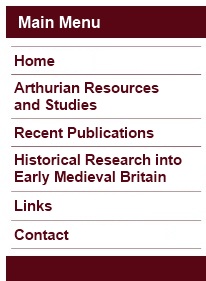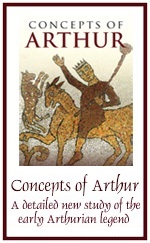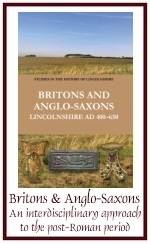
 |

|
'Tealby, the Taifali, and the End of Roman Lincolnshire', in Lincolnshire History & Archaeology, 46 (2011 [2014]), pp. 5-10. A discussion of the Lincolnshire place-name Tealby (Tavelesbi, Teflesbi), examining its origins and potential implications for our understanding of late and post-Roman Lincolnshire. It is argued, first, that this place-name derives ultimately from the group-name *Tāflas/*Tǣflas, the Old English form of the Continental tribal-name Taifali; and, second, that these Lincolnshire Taifali/*Tāflas could well have been the descendents of people who were once members of the late Roman Equites Taifali and who had played a role in the defence of the provincial capital of Lincoln both at the end of the Roman period and during the post-Roman era. [Download PDF from Arthuriana] Britons and Anglo-Saxons: Lincolnshire AD 400-650 (History of Lincolnshire Committee, 2012). An interdisciplinary study of the region around Lincoln in the period between c. AD 400 and 650, based on my doctoral thesis. Britons and Anglo-Saxons offers a detailed analysis of the nature and extent of Anglian-British interaction there; it also considers the nature of the early Anglo-Saxon population-groups present in that region and the Anglo-Saxon conquest of Northumbria. For further details of Britons and Anglo-Saxons, follow the link. [Further Details/Buy Book] 'John Dee, King Arthur, and the Conquest of the Arctic', in The Heroic Age: A Journal of Early Medieval Northwestern Europe, 15 (October 2012). A detailed study of John Dee's late sixteenth-century claim that King Arthur conquered the far northern world and North America. Although sometimes treated as Dee's own invention, the concept of Arthur as a conqueror of the Arctic and even parts of North America clearly antedates Dee. One witness to it is the Gestae Arthuri, which was seen and summarized by Jacob Cnoyen, who probably wrote in the fourteenth century. This medieval document apparently described Arthur's attempts to conquer the far north, including an expedition launched against the North Pole itself. Another witness is the Leges Anglorum Londoniis Collectae, which dates from the start of the thirteenth century and provides a list of Arthur's northern conquests, including Greenland, Vinland and the North Pole. On the basis of these and other documents, it would appear that the concept of Arthur as an Arctic conqueror can be traced at least to the later twelfth century, if not before. [Get Published Version] A Re-evaluation of the Evidence of Anglian-British Interaction in the Lincoln Region (Oxford D.Phil Thesis, 2011). My doctoral thesis, online at the Oxford Research Archive, which looks in depth at the evidence relating to Anglian-British interaction in the post-Roman Lincoln region. Note, this thesis uses endnotes, which can be inconvenient when reading online; to avoid having to move backwards and forwards within the text, a consolidated file of all endnotes has also been made available so that readers can have the text and endnotes open in separate windows. [Go to the Oxford Research Archive item page] [Direct Download of Thesis PDF] [Direct Download of Consolidated Endnotes] 'An Alternative Intepretation of Preideu Annwfyn, lines 23-8', in Studia Celtica, 43 (2009), pp. 207-13. A new interpretation and translation of the third awdl (lines 23-28) of the Book of Taliesin poem Preideu Annwfyn, in which a raid on the Otherworld by Arthur is narrated by the legendary Taliesin figure. It is argued that the third awdl of this early poem could reflect a concept of a far-northern, frozen Otherworld island-fort, and that an Arthurian raid on such a fort would have analogues in later medieval Arthurian tales. [Get Published Version] [Download PDF from Arthuriana] Arthuriana: Early Arthurian Tradition and the Origins of the Legend (2009). This book collects together the academic and popular articles which have appeared on this website since 1998. It includes ‘The Historicity and Historicisation of Arthur’, an extensive review article which gathers together and critiques scholarship on the sources for a ‘historical Arthur’; ‘A Bibliographic Guide to Welsh Arthurian Literature’, which offers a discussion of virtually every piece of early Welsh Arthurian literary material; and ‘A Gazetteer of Arthurian Onomastic and Topographic Folklore’, which looks at the early evidence for Arthur and his companions appearing in local folklore and provides a gazetteer of such occurrences. [Download PDF from Arthuriana] 'The British Kingdom of Lindsey', in Cambrian Medieval Celtic Studies, 56 (2008), pp. 1-43. A detailed study of the historical, archaeological, literary and linguistic evidence for a post-Roman British kingdom having been based at the former Late Roman provincial capital of Lincoln through the fifth century and into the sixth. It is argued that there is now a significant quanitity of evidence that points to the existence of such a polity, and that this polity was probably able to control Anglo-Saxon activity in the surrounding region for several generations. This study also looks at its lasting historical significance of such a British territory in this region. [Get Published Version] Concepts of Arthur (Tempus, 2007). This monograph examines all of the early Brittonic Arthurian sources in order to establish the nature and development of the early Arthurian legend. It is contended that by analysing the entire body of early Arthurian material, rather than just those sources which refer to a supposedly ‘historical Arthur’, significant advances are possible in our understanding of this legend. For further details and reviews of Concepts of Arthur, follow the link. [Further Details/Buy Book] 'A Note on Aladur, Alator and Arthur', in Studia Celtica, 41 (2007), pp. 237-41. A study of the Arthurian links and implications of the Book of Taliesin poem Kadeir Teyrnon. It is suggested that Arthur is the subject of the first part of this poem, and that the description of this subject as o echen aladur should be read as a indicating that he (Arthur) was ‘from the stock/lineage/family/tribe of (Mars) Alator’, a Romano-British deity. The exact import of this description is unclear, but it could have a significance beyond the merely laudatory. [Get Published Version] [Download PDF from Arthuriana] 'Tom Thumb and Jack the Giant Killer: Two Arthurian Fairytales?', in Folklore, 118.2 (2007), pp. 123-40. This study examines the chapbook tales of Tom Thumb and Jack the Giant-Killer. The earliest recorded forms of these stories are discussed and it is contended that the common dismissal of their Arthurian elements as unimportant background—Arthur’s Britain as a variant of “Once upon a time”—is unhelpful. Rather, both arguably embody and illustrate important points about the nature of the Arthurian legend in an era in which interest in this had declined considerably. It is suggested that the Arthurian element in Tom Thumb is, while not central, significant, and that it is best viewed in the context of an established pattern of development and expansion of the international Arthurian cycle which meets the needs and interests of different audiences. Jack the Giant-Killer, in contrast, seems to owe a noteworthy debt to the Arthur of Welsh and/or Cornish folklore rather than to the roi fainéant of the international legend, perhaps reflecting the decline in importance of the latter since the time of the History of Tom Thumbe. Note: this paper was reissued as a free download in 2012 as part of Folklore's special issue on 'Folklore Studies and Arthurian Tradition', ed. Professor Patricia Lysaght. [Direct Download of Published Version] [Article Page on Publisher's Site] [2012 Special Issue of Folklore frontpage] 'Trade, Gift-Giving and Romanitas: A Comparison of the Use of Roman Imports in Western Britain and Southern Scandinavia', in The Heroic Age: A Journal of Early Medieval Northwestern Europe, 10 (May 2007). Superficial comparison of Roman artifacts found in Southern Scandinavia with those of Britain demonstrates that different items were valued in the two areas. However, the Roman artifacts in both areas can be viewed as high-status luxury items. The essay argues that a comparison of the distribution of Roman artifacts in Britain and Scandinavia sheds light on their use and value within the respective importing societies. High-status Roman goods were used by local elites in both Britain and Scandinavia to help bolster their claims to authority and power. [Get Published Version] [Download PDF from Arthuriana] * * * * * Copyright © 2011, 2014 Caitlin R. Green. All Rights Reserved. To cite articles or pages from this website, use a service such as WebCite or alternatively see one of the following style citation guides. Questions and queries via email to Caitlin R. Green. |
   |